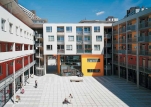Breaking Stereotypes

Underground kindergarten, tiny shell-house area of only 4.8 square meters, office building with walls made of translucent concrete ... These and other projects all over the world has been developed by an international team of architects – Peter Ebner and friends. The company was founded by the Austrian architect Peter Ebner, who always finds creative solutions for any particular challenge. He considers his partners primar ily friends and ready to accept any of their ideas, as well as the ideas of his students, with whom he works in his FutureLAB . With Professor Peter Ebner met Elizabeth Klepanova.
Peter, you probably know that our magazine is very interested in architectural innovations. Could you, please, tell us few words about the kindergarten in Rome you designed?
Well, I was always interested in build in ground. Examples like Petra in Jordan were always fascinating for me. But generally except of few classical examples people were never thinking much about potential of build into the ground. I was designing the museum of modern art in Salzburg and 1st time did it to the ground. The restaurants were organized the way that you have different rooms – chambers along the cliff with scratched out windows and the exhibition space was totally underground.
And the next time we were thinking already much more to take the possibility to build into the earth and this was our next project of the museum Heldenberg there we concentrated on space, light situation. The quality of building in earth is that you are free in form. Nobody sees the facade because everything is inside. And in the kindergarten- kids like to play outside very much, especially in the climate like in Rome. We decided to build into the ground using the original already existing landscape deformation. As a result we actually created two kindergartens. 1st for kids from 0 to 3 and the 2nd from 3 to 6. We didn’t want to make two buildings- we wanted to have one. So, we made an internal street. And then we have an outer space which connects two sides and there kids can run.
And from the pedagogical point of view is it good that two ranges of ages are in practically the same building? Because in our culture most likely it would be in very clearly separated buildings.
Let’s say in inside space they are very clearly divided. Externally they are mostly together yes. But also some playgrounds are located in different areas.
Full content of this issue you can read here
The full version of the article can be read in our printed issue, also you can subscribe to the web-version of the magazine
 Materials provided by Peter Ebner and friends
Materials provided by Peter Ebner and friends


